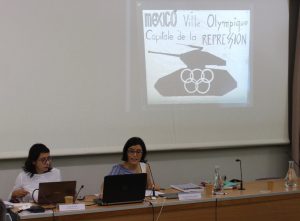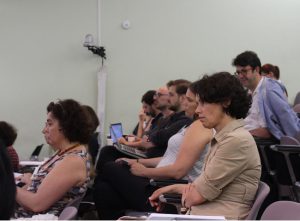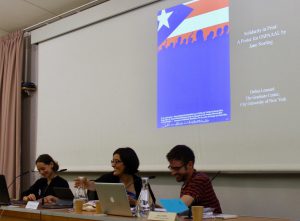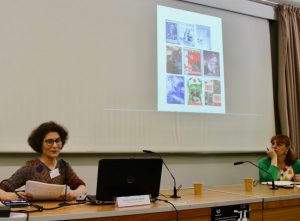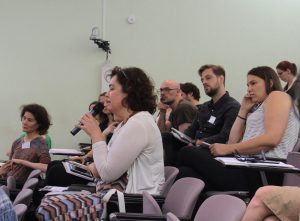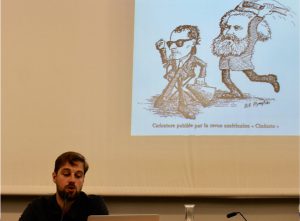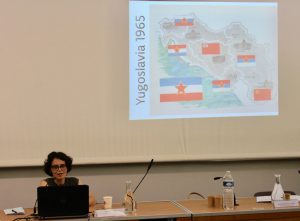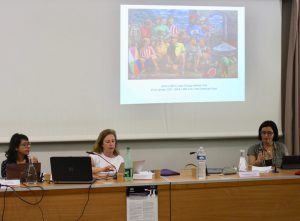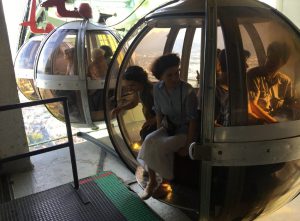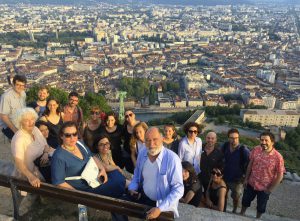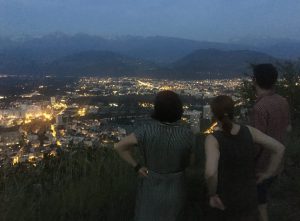International conference
Transnational solidarities and visual culture: resistance and revolutionary memories from WWII to the Cold War
Maison des Sciences de l’Homme
Université de Grenoble Alpes
24 & 25 June 2019
by Jaime Vindel
The international conference Transnational Solidarities and Visual Culture: Resistance and Revolutionary Memories from WWII to the Cold War was intended to further the cartographic reconstruction of regional and internationalist ties that were forged by the nonaligned culture of the period running from the end of the second world conflict to the fall of the Berlin Wall. The papers delivered faced this challenge in multiple directions:
1. It delineated a relational geography of the various artistic, cultural and political agents involved in this transoceanic space, with special emphasis on the role of events such as the first summit of the Non-Aligned Countries (Belgrade, 1961), projects such as the Tricontinental, organisations such as the OSPAAL (Organisation of Solidarity with the Peoples of Africa, Asia and Latin America) and geopolitical nodes built around nation-states such as Cuba or the former Yugoslavia (Bojana Piškur). Over the decades, these initiatives oscillated between the generation of poles of political-cultural revolt against the hegemonic Cold War narratives and blocks and the constitution of an autonomous institutional network parallel to the global art system.
2. It identified the way in which the circulation of the visual and revolutionary culture of resistance was re-signified in the different contexts in which the struggles of the period were inscribed (Megan Strom), with particular emphasis on the critical dissidences that unfolded around the anti-colonial critical movements, from the Black Panthers Party to the Palestinian National Authority. In this regard, the symposium evidenced that the imaginaries of revolt’s capacity of infiltration broadened the field of non-aligned countries to the point of permeating political conflicts occurring in First World geographies such as the United States, redefining the meaning that “hemispheric collaborations” took during the Second World War (Fabiana Serviddio). Examples discussed included the third-world inspiration of political graphics in Northern California (Émilie Blanc), the rebellion against internal colonialism practiced by civil rights movements and the Chicano community, the bid to transfer the right to self-determination to the recognition of Puerto Rico’s sovereignty, and the pro-Palestinian solidarity of the “cinéma du réel” in Belgium (John Nieuwenhuys).
3. In relation to the previous point, the proliferation of a common visual culture with an internationalist sign was combined with the plural materiality adopted by the various experiences analyzed. These ranged from the emphasis on the tactile quality of the posters produced to be distributed in magazines, which enabled to compose an affective and communitarian relationship between potential users (Debra Lennard), to the factographic operativity of the literature of testimony, the third cinema or photomontage (Alejandro Pedregal, Olivier Hadouchi, Cristina Cuevas-Wolf), which dynamited the rigidity of the borders between fiction and documentary, as well as avant-garde and realism, over a chronological arc spanning from the late 1950s to the early 1970s. We should add to this the capacity of non-aligned artistic enterprises to organise collective encounters that reaffirmed, on the basis of on-site work and self-instituting power, the objectives of an art understood as a social practice of context (Juliane Debeusscher); or to opt for a model of “universal choreography” that would define -not without contradictions- an aesthetic of solidarity around dance (Stephanie Gonçalves).
The connection between violence and revolution as a part of history, sustained by Franz Fanon in his book Los condenados de la tierra (1961), was thus declined in a series of practices that oscillated between the exaltation of the armed guerrilla ( re-signified through multiple associations, such as the one promoted by Sandinism with maternity and childhood (Laura Ramírez Palacio)) and its translation into contexts such as Mexico under new forms of politicization of art (Miguel Errazu) that coexisted with the inheritance of consecrated figures, such as David Alfaro Siqueiros (Irene Herner). Cultural guerrilla, to use the formula of Julio Le Parc, became a way to extend the revolution by other means; while it accompanied ongoing liberation projects, it also designed an international association of artistic wills that, towards the end of the period under review, allowed the reactivation of previous manifestations of solidarity around events such as the Havana Biennial (Anita Orzes). On the other hand, while some of the emancipatory political projects of the 1960s and 1970s were partially suffocated by military dictatorships and counterrevolutionary states of siege, these cultural networks favoured the creation of a politics of solidarity that denounced at an early stage the crimes committed by these authoritarian regimes, by circulating objects such as Chilean arpilleras (produced by women from poor neighbourhoods in Santiago (Isabel Plante)).
Photo Gallery

